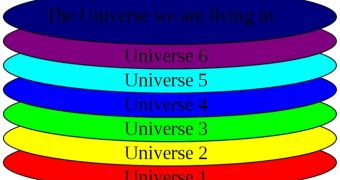Searching for life, preferably intelligent one, is one of the main goals in astronomy today. While most people know that chances are relatively slim for a third-degree encounter to actually take place, we don't lose hope because we believe finding life is a game of chance – the more exoplanets we find, the higher the chances that one of them will be in the correct orbit around its parent star. But for Alejandro Jenkins, the question of whether or not life exists is not addressed to this Universe, but rather to the other Universes existing alongside it in the Multiverse, ScienceDaily reports.
The Multiverse is a proposed construct that is believed to incorporate an infinite number of Universes, such as our own. For Jenkins, who is a Florida State University postdoctoral associate in theoretical high-energy physics, thinking like this is his second nature. Theoretical physicists usually tend to conduct their thought processes in more dimensions than the four we are accustomed to. Thanks to a cover article he co-wrote for the January 2010 issue of the esteemed publication Scientific American, he and co-author Gilad Perez, a Weizmann Institute of Science theorist too, received a lot of attention from the international scientific community.
But the focus is not on their persons, but on a theory they developed, called the anthropic principle. What it basically states is that the very existence of intelligent life, in the sense that these life forms are self-aware and capable of analyzing their surroundings, forms restrictions on the laws of physics. The two theorists say that these natural laws could have a tremendous number and possible combinations of traits and forms. But the very existence of life limits these possible combinations to a much smaller number, the team reveals.
“Our lives here on Earth – in fact, everything we see and know about the Universe around us – depend on a precise set of conditions that makes us possible. For example, if the fundamental forces that shape matter in our universe were altered even slightly, it's conceivable that atoms never would have formed, or that the element carbon, which is considered a basic building block of life as we know it, wouldn't exist. So how is it that such a perfect balance exists? Some would attribute it to God, but of course, that is outside the realm of physics,” Jenkins says.
“What theorists like Dr. Perez and I do is tweak the calculations of the fundamental forces in order to predict the resulting effects on possible, alternative universes. Some of these results are easy to predict; for example, if there was no electromagnetic force, there would be no atoms and no chemical bonds. And without gravity, matter wouldn't coalesce into planets, stars and galaxies,” he adds.
“What is surprising about our results is that we found conditions that, while very different from those of our own universe, nevertheless might allow – again, at least hypothetically – for the existence of life. (What that life would look like is another story entirely.) This actually brings into question the usefulness of the anthropic principle when applied to particle physics, and might force us to think more carefully about what the Multiverse would actually contain,” Jenkins concludes.

 14 DAY TRIAL //
14 DAY TRIAL //